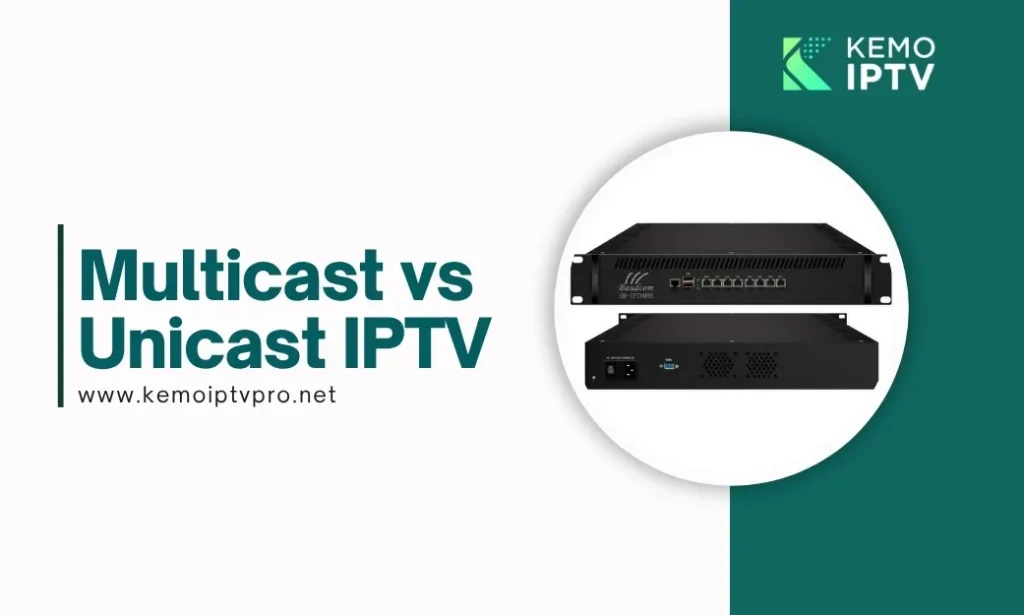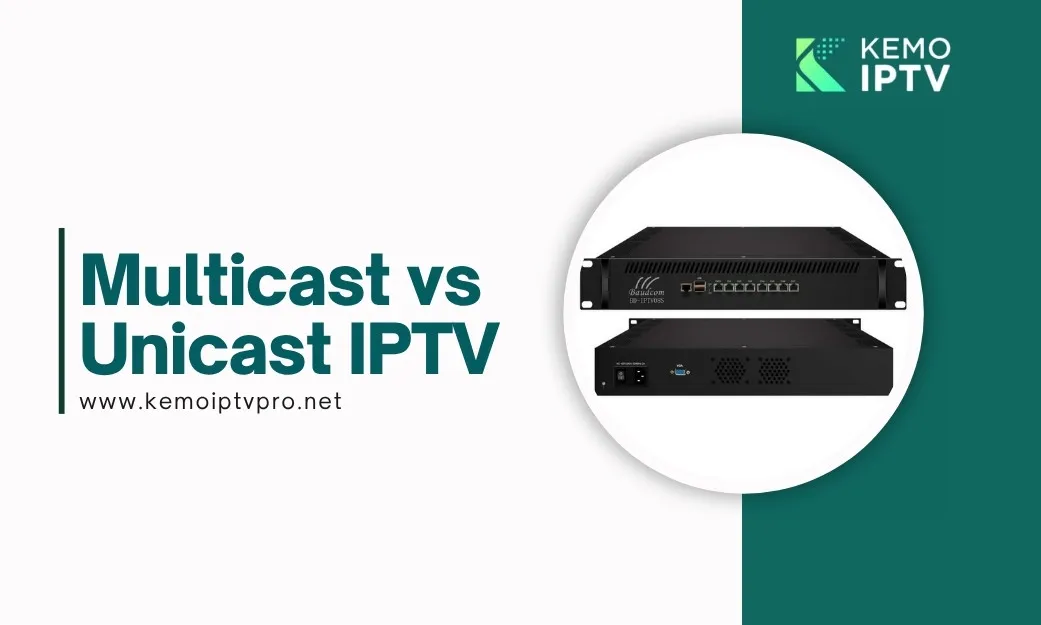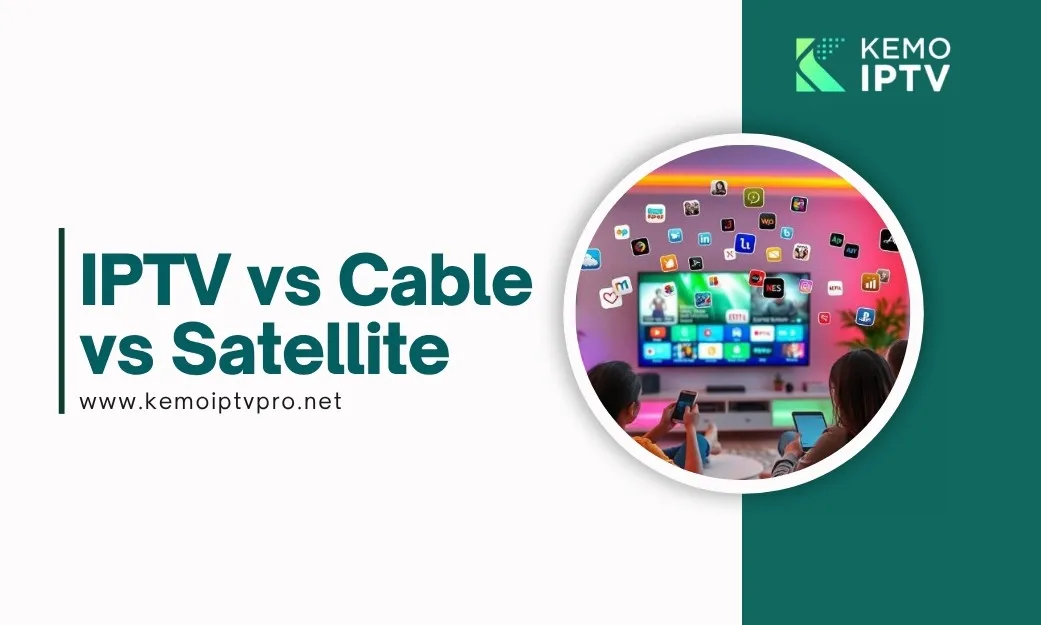If you’re exploring IPTV (Internet Protocol Television) systems or wondering why your streaming service behaves differently than traditional cable TV, understanding the difference between multicast and unicast delivery is essential. These two transmission methods represent fundamentally different approaches to delivering video content over IP networks, and each has specific strengths that make it ideal for certain scenarios.
As more viewers cut the cord and move to IP-based television services, networks face mounting pressure. When millions tune into the same live event, should each viewer get their own individual stream, or should everyone share one broadcast? This choice between unicast and multicast isn’t just technical minutiae—it’s the difference between a smooth viewing experience and a network meltdown.
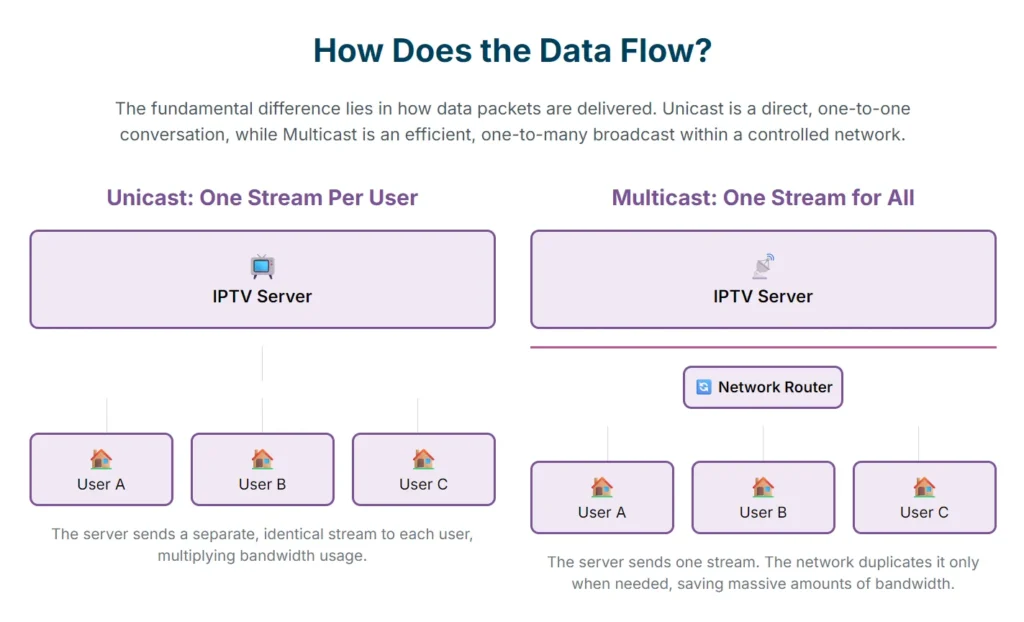
What is Unicast in IPTV?
Unicast is a one-to-one streaming method where the server delivers an individual, dedicated stream to each client device. Think of it like making separate phone calls—each viewer who requests a channel or video gets their own unique connection from the source.
How It Works
Unicast streams typically use standard protocols like HTTP over TCP or UDP for real-time content. These streams travel over the internet like regular web traffic, which means they’re universally supported on all networks without special configuration. Popular platforms like Netflix, YouTube, and Amazon Prime rely entirely on unicast delivery. When you press play, the server establishes a direct connection with your device and begins streaming content specifically to you.
To handle millions of viewers, content providers use Content Delivery Networks (CDNs) that cache and distribute streams from servers located closer to users. This distribution system is necessary because a single origin server can’t handle millions of direct connections simultaneously.
Key Advantages
The beauty of unicast lies in its flexibility. Each stream is independent, allowing viewers to pause, rewind, or watch entirely different content at different times. This personalization is impossible with a shared broadcast stream. Unicast also works over standard internet infrastructure with no special network requirements, making it easy to deploy anywhere. Each viewer’s stream can be independently managed, secured, and encrypted.
Notable Limitations
The major drawback is bandwidth inefficiency. When 1,000 people watch the same 5 Mbps live stream via unicast, the system must generate 1,000 separate streams, consuming approximately 5,000 Mbps (5 Gbps) of total bandwidth. This duplication becomes expensive fast—content providers must provision massive bandwidth and CDN capacity for peak traffic, and costs scale linearly with audience size.
Netflix’s live-streamed boxing match in November 2024 illustrated these limitations dramatically. Drawing 65 million simultaneous streams—the largest audience ever on the platform—the all-unicast delivery strained infrastructure significantly. Many viewers experienced video freezes and lag as caches hit capacity. Industry experts noted that IP multicast could have alleviated this by delivering one feed to all viewers without overload, but Netflix’s adaptive streaming format and public internet delivery aren’t natively compatible with multicast technology.
What is Multicast in IPTV?
Multicast takes a radically different approach: it’s a one-to-many streaming technique where a single stream from the source is distributed to multiple receivers simultaneously. Rather than addressing packets to specific devices, multicast sends data to a “multicast group”—any user who joins that group receives the identical stream.
How It Works
Multicast typically uses UDP and special Class D IP addresses (224.0.0.0 to 239.255.255.255). The magic happens in the network infrastructure itself—routers and switches replicate the stream for various network branches, ensuring each packet travels each network link only once. When you tune to a channel, your set-top box signals interest via the Internet Group Management Protocol (IGMP), and the network adds you to that channel’s distribution group. If no users in a local network segment want a particular channel, the stream stops at that segment, saving bandwidth.
Common Applications
Multicast is the backbone of managed IPTV services offered by telecommunications providers. For instance, an ISP might multicast 200 live TV channels over its fiber network to subscribers’ set-top boxes. It’s also used in corporate networks for company-wide video streams and in niche applications like financial trading data feeds that need to reach many endpoints instantly.
Key Advantages
The efficiency is staggering: one stream serves many receivers, regardless of audience size. Whether 10 or 10,000 people tune in, the source sends only one copy, and the network handles distribution. This prevents network congestion during high-demand events and means adding viewers doesn’t significantly increase server or network strain. According to industry analyses, multicast can achieve up to 80% bandwidth savings compared to unicast for live video delivery.
All users receive the stream simultaneously, ensuring synchronized viewing—critical for live sports where spoilers travel fast. The economic benefits are equally compelling: bandwidth and server output don’t scale per user, so providers can serve massive audiences without proportional CDN costs.
Notable Drawbacks
Multicast’s Achilles heel is its infrastructure requirement. All routers, switches, and ISPs in the delivery path must support IP multicast routing and group management. This confines multicast IPTV to provider-managed networks—most of the public internet does not carry multicast traffic. Setting up multicast involves configuring complex protocols like IGMP and Protocol Independent Multicast (PIM), making it technically challenging to deploy and maintain.
By design, multicast sends identical content to everyone in the group. Viewers can’t independently pause or request different videos in a pure multicast system. This lack of per-user flexibility limits multicast primarily to linear live content. Additionally, multicast over UDP doesn’t automatically handle packet retransmission, requiring extra mechanisms to ensure reliability.
Unicast vs. Multicast: Key Differences
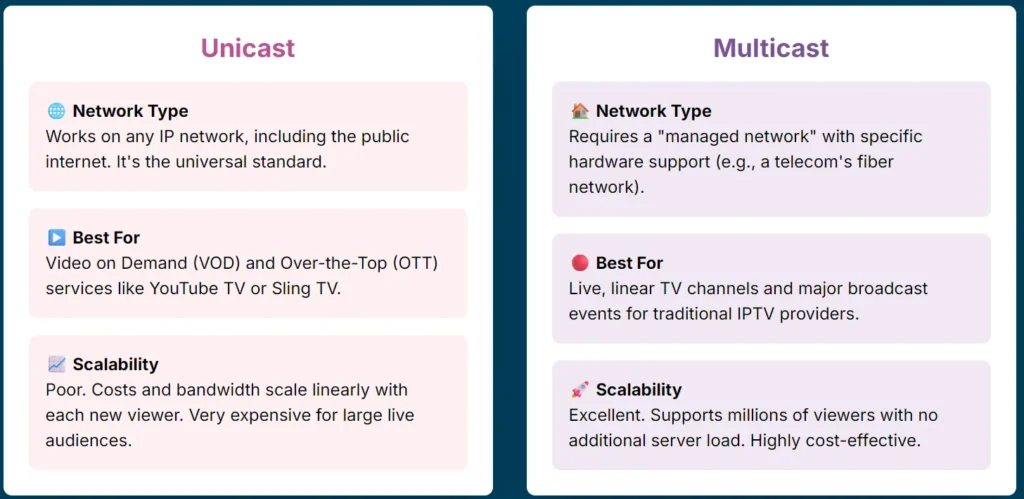
The fundamental distinction is architectural: unicast creates private channels between server and client (one-to-one), while multicast is like a conference broadcast (one-to-many). When 1,000 people watch the same show, unicast means 1,000 separate streams; multicast delivers one stream that 1,000 people share.
Bandwidth and Scalability
Unicast bandwidth consumption grows linearly—more users equals proportionally more traffic, which can quickly congest networks. Multicast uses bandwidth far more efficiently: whether 10 or 10,000 viewers tune in, the network carries essentially one stream. This difference fundamentally alters economics. For a typical 15 Mbps HD channel with 100 viewers, unicast demands 1.5 Gbps while multicast needs only 15 Mbps.
Infrastructure Requirements
Unicast works on any typical IP network across the internet without special configuration—it’s the default mode of IP traffic. Multicast requires end-to-end network support; if any segment doesn’t support multicast, those viewers can’t be reached. This explains why multicast IPTV is confined to ISP managed networks, whereas OTT content over the public internet uses unicast by necessity.
Use Case Suitability
Use unicast when viewers demand interactivity or unique content streams—VOD catalogs, time-shifted viewing, or personal device streams. Use multicast for simultaneous consumption of identical live content by many people—live TV channels, sports events, or digital radio.
The viewer experience differs too. With unicast, users might experience varying latencies based on their connection—one viewer might be 30 seconds behind another. With multicast, everyone joins the same feed and sees content virtually in sync. Quality is uniform (determined by the single stream’s bitrate), though it doesn’t adapt per user as adaptive bitrate unicast does.
When to Choose Unicast
Unicast shines for on-demand content and personalized streams. If you need user-specific delivery—different channels or start times for each user—unicast is the straightforward choice. It works well if concurrent usage is moderate or if content is unique per user. The flexibility to leverage existing internet infrastructure and scale using CDNs makes it accessible for any service.
However, unicast struggles with mass live events. It’s not bandwidth-efficient when thousands watch identical content simultaneously, and costs escalate as audiences grow due to per-user streaming expenses. Major providers require extensive CDN support to handle big audiences, and slight delays can vary by user.
When to Choose Multicast
Multicast excels for live, linear broadcasts to large audiences on managed networks—ISP-delivered TV channels or company-wide streaming events. When you control the network and many viewers consume identical content concurrently, multicast hugely optimizes delivery.
The managed IPTV market, valued around $115 billion in 2022 and continuing to grow, relies heavily on multicast for live television distribution. The efficiency gains are substantial: one analysis found that scaling a CDN for live TV costs around $6 per additional user, whereas multicast-based solutions can lower this to just $1 per user.
However, multicast only works if your network supports it end-to-end—it’s not viable over the open internet. Setup and maintenance are complex, and it’s not suitable for on-demand or individualized content. There’s dependency on network hardware, which might need upgrades.
Real-World Hybrid Solutions
The industry increasingly adopts hybrid models. AT&T’s U-verse service, for example, uses a clever approach: when subscribers tune to a channel, the stream initially begins as a fast-starting unicast feed, then seamlessly switches to the main multicast stream after a few seconds. This minimizes channel-switching time while leveraging multicast’s efficiency for sustained viewing.
Innovative solutions are emerging to bridge these worlds. In late 2023, UK telecom BT announced a Multicast-Assisted Unicast (MAUD) system. During 2024 trials, BT’s network automatically switched concurrent viewers to multicast for the same live content, reducing peak traffic load by up to 50% and converting over 60% of streaming traffic from unicast to multicast—all while remaining compatible with users’ existing streaming apps.
Multicast Adaptive Bitrate (mABR) represents another evolutionary step, combining multicast’s efficiency with adaptive bitrate streaming’s flexibility. The system uses a “transcaster” at the head-end to encapsulate ABR streams into multicast transport, then an “agent” on customer gateways converts traffic back to standard unicast ABR for home devices. This retains multicast’s bandwidth savings while enabling quality adaptation.
Making the Right Choice
Content type should drive your decision. Single live channels or events viewed simultaneously by many people benefit enormously from multicast efficiency. On-demand content or interactive libraries require unicast’s flexibility. Many successful providers use both: multicast for linear live channels, unicast for catch-up TV and VOD content.
Audience size matters. Multicast yields significant benefits when audiences are large and watching concurrently. For smaller user bases or staggered viewing times, unicast might be simpler and sufficient.
Your network environment is crucial. If you control a managed network—ISP, campus, or enterprise LAN—and can configure multicast, the option exists. Delivering over the public internet or networks without multicast support? You’ll likely need unicast or hybrid CDN approaches.
Conclusion
Understanding multicast versus unicast isn’t just technical knowledge—it’s fundamental to delivering high-quality IPTV experiences. As researchers at Ericsson explain, “it would be unrealistic to design a network for massive unicast capacity everywhere. Therefore, using unicast alone would not be a scalable solution.”
Neither method is universally superior. Unicast provides essential personalization and works everywhere, making it perfect for on-demand content. Multicast delivers unmatched efficiency for live broadcasts but requires the right infrastructure. The future belongs to hybrid architectures that intelligently combine both, leveraging each method’s strengths while mitigating its weaknesses.
As streaming audiences grow and live events become more common online, the balance between these technologies will become increasingly critical. Whether you’re a network engineer planning infrastructure or a content provider evaluating delivery options, mastering this balance will determine whether you can deliver smooth, reliable streams without breaking the internet—or your budget.

